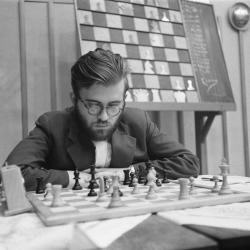GM Bent Larsen

Bio
Bent Larsen was a Grandmaster, and is considered the strongest Danish player of all time. He reached his peak in 1971, when he was the #3 player in the world (behind Bobby Fischer and Boris Spassky). Larsen had a long career, and he defeated every world champion he faced while active (Botvinnik, Smyslov, Tal, Petrosian, Spassky, Fischer, and Karpov). He competed in the world championship cycle 4 times, and was a 6-time champion of Denmark.
Larsen's style was very unique and original. His imaginative play was mixed with taking risks and utilizing the element of surprise, qualities that are uncommon at the highest level of chess. He often used offbeat openings, and was a specialist in flank openings (e.g. the Nimzo-Larsen attack with 1.b3, Bird's opening with 1.f4, and the English). Larsen was also known for pushing his rook pawns in closed or semi-open positions, as is seen in this gem of a game played versus World Champion Petrosian:
Larsen learned to play chess at the age of 7, but he didn’t start taking chess seriously until he was 17 years old. It was at this time that he dropped out of school in order to pursue a career in chess. He became an International Master at the age of 19 in 1954. In 1956, he played first board for Denmark in the Moscow Olympiad. His gold medal performance at this Olympiad earned him the Grandmaster title. In his early professional career, he played very solid chess and didn't take many risks. His development stalled a little bit until the early 1960s, when he started to change his playing style a bit.

Larsen started playing offbeat openings, and began employing more surprises and imaginative play around 1963. It was at this time that his unique style started to blossom, and his growth to become a world class player occurred. In the 1964 Amsterdam Interzonal tournament, armed with his new style and opening repertoire, he tied for 1st-4th place with Tal, Smyslov, and Spassky.
His impressive finish in the 1964 Interzonal earned him his first spot as a world championship candidate. In the 1965 Candidates' matches, he defeated Ivokov but narrowly lost to former World Champion Tal in the semifinals. In 1965, Larsen played one of the nicest attacking games of his career. The final position is one to remember:
In between cycles, Larsen excited the chess world with brilliant sacrifices and unusual opening and middle game ideas. In the 1966 2nd Piatigorsky cup in Santa Monica California, Larsen finished third behind Spassky and Fischer. In this tournament, he defeated the newly crowned World Champion Petrosian twice! Here is a famously brilliant attacking game from Larsen, where the attack starts with a sacrificed pawn before giving up a queen for a mating net:
In 1967, Larsen would again qualify for the candidates' matches after winning the Sousse Interzonal. In 1968, he defeated Portisch, but again lost in the semi-finals (this time to Boris Spassky, who would become World Champion in 1969). 1970 was another successful year for Larsen, who won more tournaments.
He won the tournament in Lugano, and played board one for the world team (Fischer played board 2) in the famous World vs. USSR match. In the same year, he finished 2nd in the Palma de Mallorca Interzonal behind Fischer to qualify as a world championship candidate for the third time. Here is another wonderful attacking example from Larsen where we again see him push a rook pawn (this time the h-pawn) into enemy territory, followed by wonderful sacrifices:
In the 1971 candidates' matches, Larsen defeated Uhlmann. Unfortunately, he then ran into the seemingly invincible Fischer in the candidates' semi-final. Fischer defeated him 6-0 on his way to becoming world champion. Larsen would not compete as a candidate again until qualifying for the 1977 candidates' cycle, after winning the 1976 Leningrad Interzonal. In the 1977 candidates' match, Larsen faced his old rival Portisch (who Larsen defeated in 1968). Portisch got his revenge in this match, and ended Larsen's career fighting for the World Championship.

Despite being an elite world class player, Larsen often entered large open tournaments around the world (and won many of them). He was extremely active throughout his entire chess career, and was considered the strongest threat to the Soviets (alongside Fischer). His legacy lives on today, through the study of the games he played. The chess world continues to see players at all levels playing opening repertoires similar to Larsen's. Hikaru Nakamura and World Champion Magnus Carlsen have won many games starting with one of Larsen's pet openings (the Nimzo-Larsen attack with 1.b3), although these games are mostly in bullet and blitz time controls. With the exception of Carlsen, Larsen is the strongest player of all time from Scandinavian countries.


